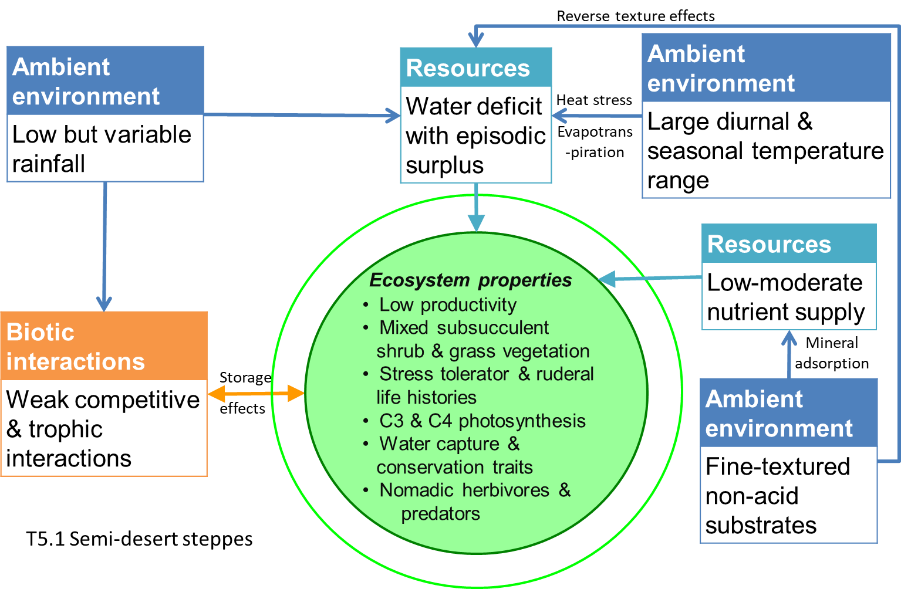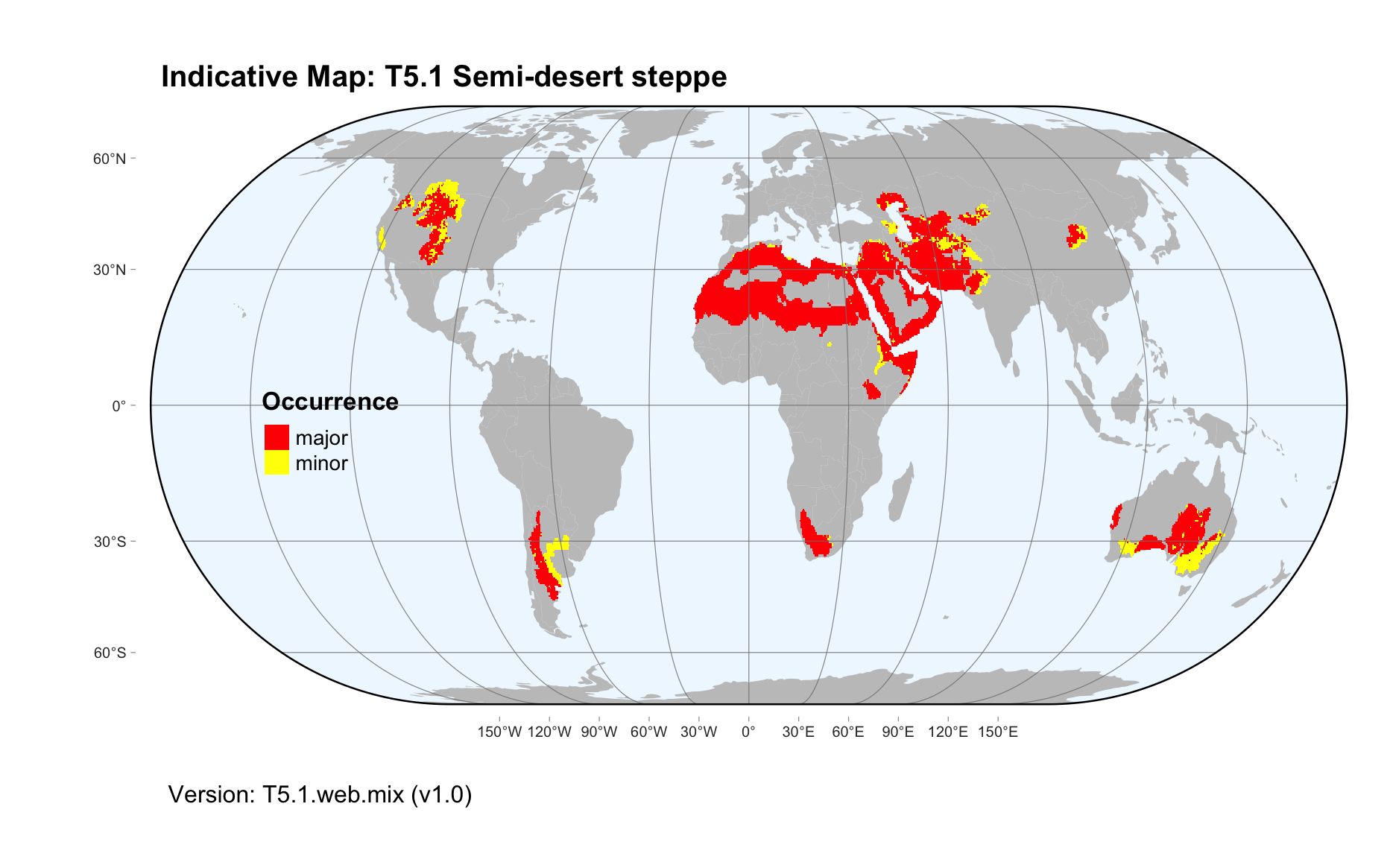Global ecosystem typology
Alternative site for the Global ecosystem typology with additional information for ecosystem profiles and indicative maps.
This site is maintained by jrfep
T5.1 Semi-desert steppe
Biome: T5. Deserts and semi-deserts biome
Contributors:
(texts)
Semi-desert steppes on all continents are dominated by perennial shrubs, often with semi-fleshy or velvety foliage, and tussock grasses interspersed with bare ground. Low variable rainfall and extreme temperatures favour flora and fauna with drought and stress-tolerance adaptations, such as deep roots and nomadism. Growth and reproduction of shrubs and grasses is varies with rainfall, the cover of grass diminishing to near zero in extended droughts. Grass cover also depends on soil fertility and grazing animals, which may also limit shrub recruitment and growth. These steppes are among the most productive of desert ecosystems, with relatively abundant small and large herbivorous and seed-eating mammals supporting bird and mammal predators and scavengers.
Key Features
Low-productivity and low-stature shrublands, tussock-grass and mixed, with episodic trophic pulses driven by variable rainfall.
Overview of distribution
Global temperate-arid regions with high temperatures and low and variable precipitation.
Profile versions
- v1.0 (2020-01-20):
- v2.0 (2020-06-15): MG Tozer; DJ Eldridge; DA Keith
- v2.01 ():
- v2.1 (2022-04-06): MG Tozer; DJ Eldridge; DA Keith Full profile available at official site
Main references
Selected references for this functional group:
Eldridge DJ, Travers SK, Facelli AF, Facelli JM, Keith DA (2017) The Chenopod shrublands Australian vegetation (Ed. DA Keith), pp 599-625. Cambridge University Press, Cambridge. ISBN 978-1-107-11843-0
West NE (1983) Comparisons and contrasts between the temperate deserts and semi-deserts of three continents Ecosystems of the World Vol. 5. (Ed. NE West) pp. 461–472. (Elsevier: Amsterdam)
Diagrammatic assembly model

Maps
Maps are indicative of global distribution patterns are not intended to represent fine-scale patterns. The maps show areas of the world containing major (coloured red) or minor occurrences (coloured yellow) of each ecosystem functional group. See general notes on maps.
There are 2 alternative versions of the indicative map for this functional group, please compare description and sources below.
T5.1.IM.mix_v1.0
Datasets
- Resolve-Ecoregions-2017
- EarthEnv-LandCover-v1.0
Map references
Dinerstein E, Olson D, Joshi A, Vynne C, Burgess ND, Wikramanayake E, Hahn N, Palminteri S, Hedao P, Noss R, Hansen M, Locke H, Ellis EE, Jones B, Barber CV, Hayes R, Kormos C, Martin V, Crist E, Sechrest W, Price L, Baillie JEM, Weeden D, Suckling K, Davis C, Sizer N, Moore R, Thau D, Birch T, Potapov P, Turubanova S, Tyukavina A, de Souza N, Pintea L, Brito JC, Llewellyn Barnekow Lillesø JP, van Breugel P, Graudal L, Voge M, Al-Shammari KF, Saleem M (2017) An Ecoregion-Based Approach to Protecting Half the Terrestrial Realm, BioScience 67: 534–545. DOI:10.1093/biosci/bix014. Data-set available on-line
Tuanmu, M.-N. and W. Jetz (2014) A global 1-km consensus land-cover product for biodiversity and ecosystem modeling Global Ecology and Biogeography 23(9):1031–1045 DOI:10.1111/geb.12182
T5.1.web.mix_v1.0

Datasets
- Resolve-Ecoregions-2017
- EarthEnv-LandCover-v1.0
Map references
Dinerstein E, Olson D, Joshi A, Vynne C, Burgess ND, Wikramanayake E, Hahn N, Palminteri S, Hedao P, Noss R, Hansen M, Locke H, Ellis EE, Jones B, Barber CV, Hayes R, Kormos C, Martin V, Crist E, Sechrest W, Price L, Baillie JEM, Weeden D, Suckling K, Davis C, Sizer N, Moore R, Thau D, Birch T, Potapov P, Turubanova S, Tyukavina A, de Souza N, Pintea L, Brito JC, Llewellyn Barnekow Lillesø JP, van Breugel P, Graudal L, Voge M, Al-Shammari KF, Saleem M (2017) An Ecoregion-Based Approach to Protecting Half the Terrestrial Realm, BioScience 67: 534–545. DOI:10.1093/biosci/bix014. Data-set available on-line
Tuanmu, M.-N. and W. Jetz (2014) A global 1-km consensus land-cover product for biodiversity and ecosystem modeling Global Ecology and Biogeography 23(9):1031–1045 DOI:10.1111/geb.12182
Check: the Glossary / Profile structure / the public document